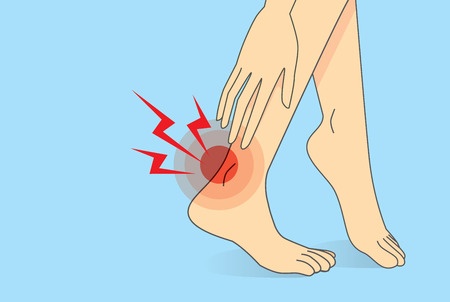
There are many different kinds of ankle injuries – all of which are defined by the kind of tissue that is damaged; Bone, ligament or tendon.
3 Frequent Ankle Injuries, Symptoms and Treatments:
Ankle Sprains
An ankle sprain is when the ligaments in the ankle are stretched or torn. Ankle sprains happen most often in sports, but they can happen just as easily during non-sport walking.
Symptoms:
Swelling, bruising, tenderness, itching, stiffness, cold or numb feet and feeling or hearing a “POP” when the injury occurs.
Treatment:
Treatment of an ankle sprain depends on the severity of the sprain. If the tendon has just been stretched, it will usually heal on its own with a little TLC – elevation, cold compress, NSAIDs (non-steroidal anti-inflammatories) and time. If you have a more severe ankle sprain (torn instead of stretched), you may need to wear a removable boot to help you walk on it or you may even need to be immobilized while it heals. Physical therapy or surgery may be recommended for the most severe cases.
Ankle Fractures
The ankle is made up of 3 main bones: the tibia, the fibula and the talus. Ankle fractures occur when there is a break in one of these three bones.
Symptoms:
Pain, swelling of the ankle, bruising around the joint, and/or visibly misshapen bones (in severe breaks only).
Treatment:
Staying off your ankle, keeping it elevated, applying cold compresses and taking an NSAID (such as ibuprofen) are suggested ways to treat an ankle fracture until you are able to see your doctor. There are different treatment plans depending on the location and severity of your ankle fractures. You may only need a splint or cast. Some injuries may need to have the bones realigned before a splint or cast is put on. More severe ankle fractures may require surgery.
Peroneal Tendonitis
There are two peroneal tendons in the foot that run behind the outer ankle bone. The peroneal tendons’ main function is to stabilize the foot and ankle, protecting them from injury. Peroneal tendonitis is when one or both of the peroneal tendons become inflamed due to overuse, repetitive use or distress.
Symptoms:
Pain around the back and outside of the foot, swelling and being warm to the touch.
Treatment:
Typically, peroneal tendonitis can be treated at home. The favored TLC routine of rest, elevation, cold compresses and non-steroidal anti-inflammatories should do the trick. Other options include strengthening the calf and peroneal muscles with stretching, shoe inserts to help correct any abnormal foot placement and/or physical therapy.
If you have a foot condition you think you need to see a professional about, please visit our website at www.sweeneyfootankle.com to schedule an appointment or contact us at one of our two convenient locations in The Woodlands or Magnolia.






